| |
| |
| -- 30th October to the 10th November 2011 -- |
| |
|
From the busy Dakar to the quiet backwaters of the Saloum river, our stay in Dakar offered us some contrasted pictures, but always typical.
More pictures of the hottest autumn ever on our page "Pictures".
|
|

Sailed 201 miles
4272 miles since the start
|
|
|
|
| |
|
30th October to 4th November : Dakar and its surroundings (8 M)
|
|
|
We chose the Cercle de Voile de Dakar (CVD) to stay in the capital. It is located in the wide and well sheltered bay of Hann and offers a large space of uniform good holding sand ground 3m deep. Easy to get in if you keep an eye out for the masts of a wreck emerging at the entrance, just on the line between the end of the military jetty and the anchorage self: approach by the east (on your right).
|
|
|
Just things first after 8 days at sea: sleep! Then we call for the yellow shuttle service from the club – still too lazy to inflate our own tender. Moussa welcomes us and asks whether we’ve been here before. He recognized Satimbanque indeed from his previous stay 7 years ago with the previous owners! He shows us around in the CVD, a very well kept “yacht club”, secure and clean, with showers, bar, internet but also various services from the sail-maker to the outboard engines workshop. Whatever you need (and even what you don’t need actually), you will always find someone more than happy to provide – be it eggs, laundry, water / gas bottles, peanuts etc. Just out of the gate Fala sells everything in his shop and changes Euros into CFA. Taxis can be found on the street at any time, as well as fruits and veggies – and beautiful African clothes, just in case you urgently needed some. Easy, you just have to ask!
|
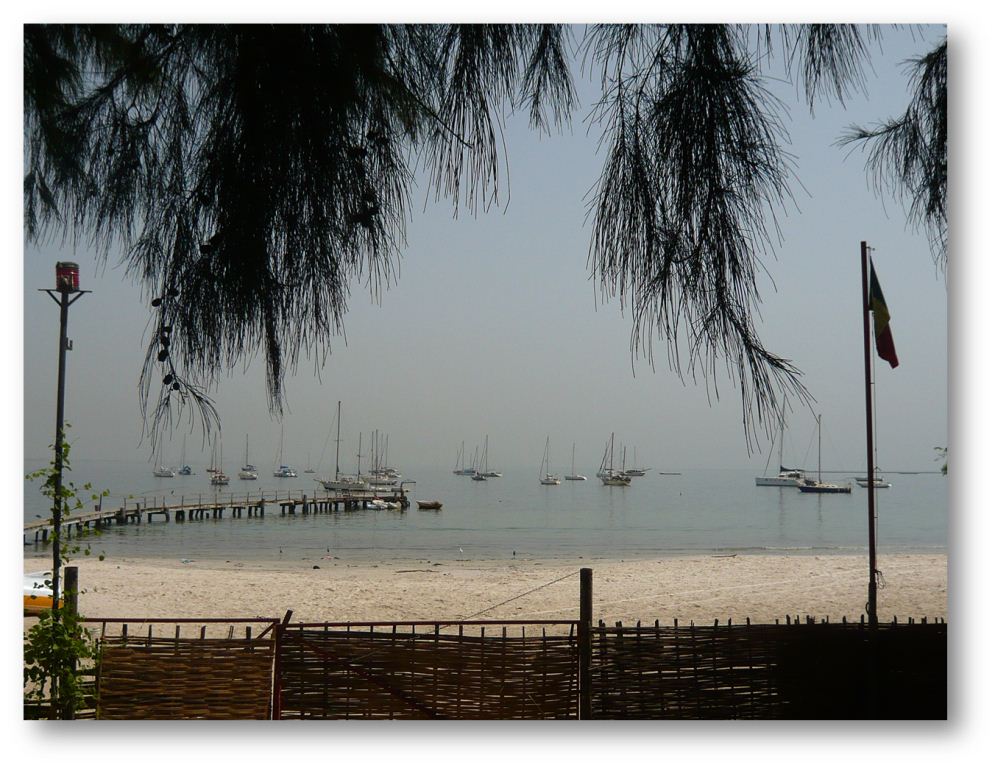
The anchorage seen from inside the CVD (can you see Saltimbanque??). Tenders are safely moored at the end of the pier.
|
|
It’s quite cheap (22500 CFAs or 33 euros for a week, 2 persons onboard). It feels peaceful and safe, and soon very much like home indeed.
Our time in Dakar will be well spent between visits and small repairs – the latter part taking more and more time as we progress in our journey as it seems!!
The work :
There are the things that we have wanted to do since long and always procrastinated, and the things that broke during our last crossing – finally even things that broke at the anchorage itself, as we were fixing others (never ending story).
|
|

Easy to access - and comfortable too, as we measure 35 degrees in the cabin...
|
The most worrying part was to us the issue with the battery isolator, preventing the engine to charge the batteries. After asking here and there it appears that we can’t find the piece in Dakar. So we’ll have to live with the temporary arrangement based on our good old crocodile clips until the Cape Verdes.
|
|
Next on the list was a check-up of our precious wind pilot Bob: he has well deserved a cleaning, changing of the ropes, fixing the attach on the helm that broke at sea.
Of course Nestor the not-less-precious engine is not forgotten: cleaning, changing the oil, fixing a small oil leak, setting up a small fan to help cooling down in those hot seas…
|

Laure picks the option: in the shade, knotting new knots on the windpilot.
|
|

Here you go, a brand new tender cover for 3750 CFA (about 5 euros)
|
So much for fixing the damages. We also expected to have a cover made to protect the tender against violent sun UVs and some small work done on the genoa by the sail-maker here. Diego works well and is reliable but he charges European prices and sometimes more as he imports all his fabrics from Europe… 150 € on the genoa we can live with it, but as much for a tender cover, no thanks, we’ll do it alone! The oilcloth we find in town (5 €) may not be first quality but it makes a colorful tailored cover, with very few seams and just a couple of holes for the handles. And it even matches the colors of Saltimbanque!
|
|
|
That would have been enough to keep us busy but you’re never done with fixing stuff on a boat, even at the anchorage! On day 1 the blue sunshade protecting us in the cockpit (made here in Dakar, 7 years ago!) is torn at a corner in a windgust. As we have the needles and strings out, we might as well fix the mosquito-net to make our bed completely mosquito-proof (there’s malaria around here…). Add to that two pants torn in quick move of our sweating legs and the national flag of our next stop: you soon find out that needles and strings are indispensable on a boat! And just as a distraction from the sewing, the outboard engine of our tender breaks one night – luckily just a very rusty piece inside it breaks actually, that commands the fuel entry: that’s fixed again.
|

Our mosquito-net has « double effect », protects both the bed and the cabin, thanks to the elastic fixed to the window.
|
|

Saltimbanque anchored in front of the CVD. Can you see what changed during our stay?
|
When all is done, we have to fill up again about everything: water (in 25L tanks in the kitchen of the CVD, then back onboard with the tender), food, diesel, clean clothes…
In the time that’s left we nevertheless explore and enjoy this new city, country, continent!
|
|
| |
|
|
The CVD is located outside of the city itself in a neighborhood that appears to us rather residential (Bel Air). It doesn’t mean that it’s empty and quiet, far from there! The suburbs like the city are bustling with people, emerging from nowhere, like they lived on the street, sitting in the shade of the pirogues or in small huts on the side of the roads. Outside of the city just means that you need a taxi (2000 CFA) or a bus (100 – 150 CFA) to get downtown.
But before venturing so far we explore the immediate surroundings of the CVD. Our first trip is to the fish market, about 500m to the East. The pirogues come back full to the beach where fish is sold immediately in big and small quantities, or prepared to be trucked away in the ice produced in the warehouse nearby. It is a busy center there, a noisy mix of housewives doing their shopping amongst wholesalers packing, kids selling all kind of small stuff from baskets. Every service, every action is the opportunity for a small job here, like peeling the fish or selling plastic bags by the unit to carry your purchase. In the dusty way leading to the main road a handful of vegetables are on display. Not enough to fill up our “fridge” certainly, but as for the fish, it can’t be fresher!
|
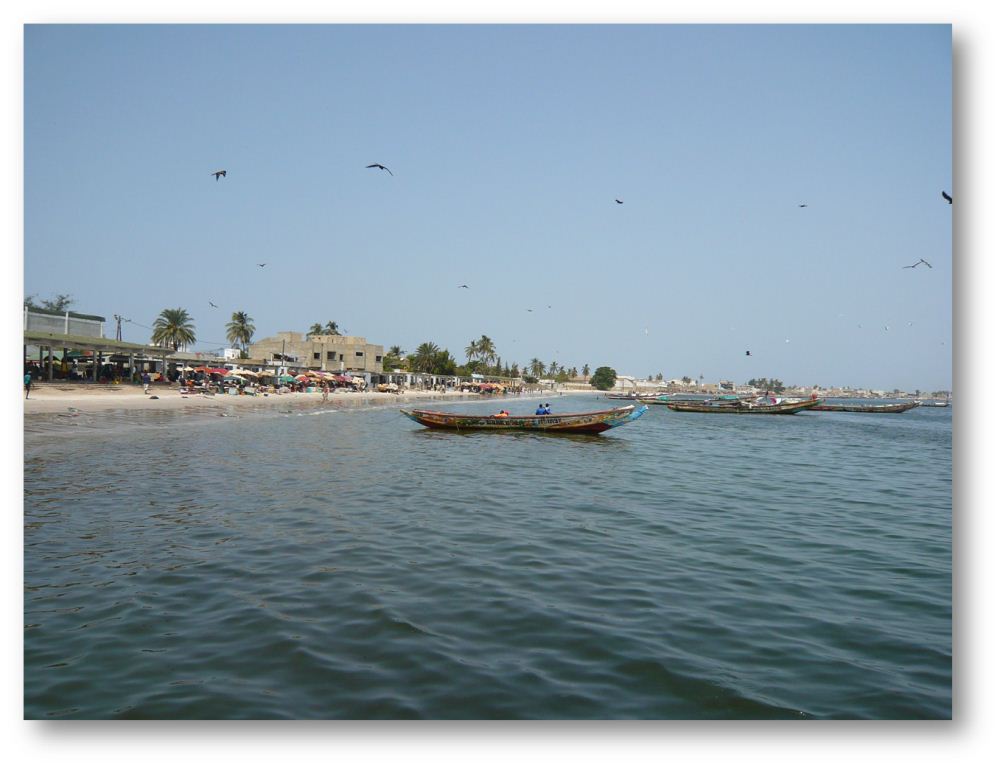
The fish market in Hann : « how's that, not fresh my fish ?!! »
|
|
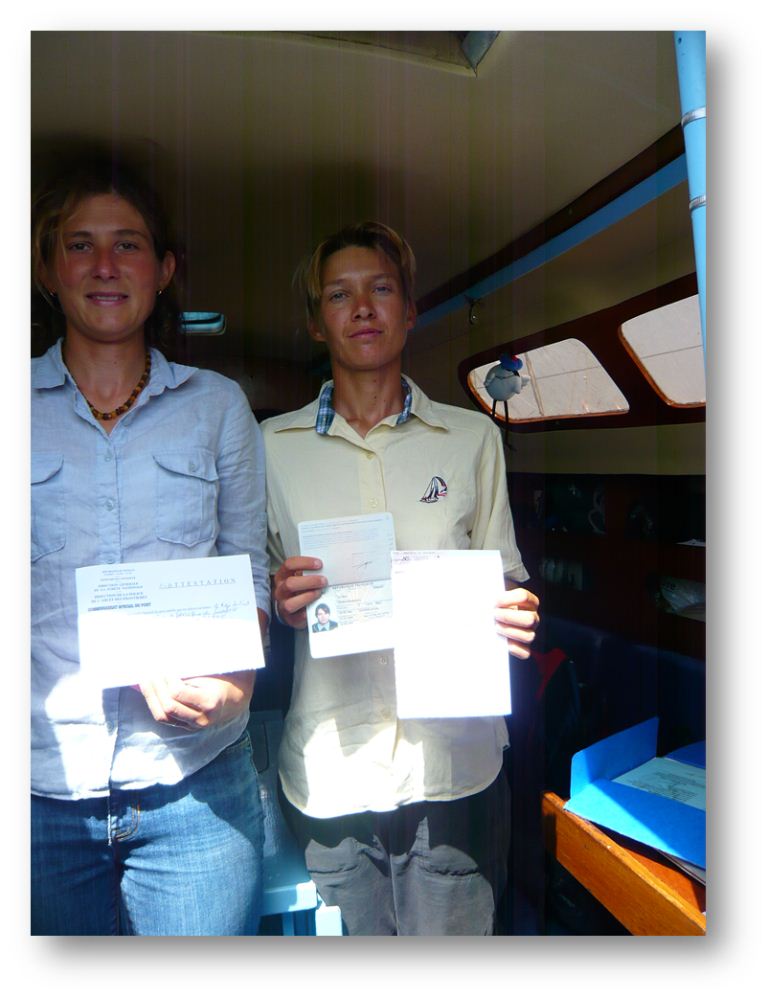
Legal aliens, with papers
|
Thus well fed, we wait for Monday that the offices open again and go to the city to clear the entrance formalities to the country (having put on our nicest shirt and cleanest trousers for the occasion). A taxi will drive us to the two places and back to the CVD for 5000 CFA. First the “Commissariat Special du Port” check the papers of the boat and passports and keep a copy of the three with them until we leave (always have a copy of your papers ready to hand out!). They stamp the passports, all quick and efficient, no trace of an hesitation nor the intention to ask for anything. Impressed we head to the next stop, the Customs. Less formal and more jovial but equally efficient and professional, they check everything and remit us the “Passavant” (authorization to stay with the boat for a month) against the official fee of 5000 CFA. Done, back to the boat before noon, all in order… and better so! For the same afternoon a patrol boat from the Customs comes alongside us and asks for the papers! They’re happy and leave immediately. Yet at night when we are cooking diner, another patrol boat comes back and this time insist on coming onboard. Two men stay inside Saltimbanque for a good hour, asking all kind of questions and even searching a bit in the cupboards and the front cabin with their flashlights. Once again nothing is being directly asked, despite annoying continuous remarks about our supposed wealth (we’re white, hence rich). Relieved as they get off. Their pilot boat will remain at the anchor nearby for a couple of days.
|
|
So now we are fed, and in order: we can get out and explore the capital. The adventure starts with finding the bus going to town: outside of the CVD left, then to the main road. All kinds of buses are honking their way through the crowd and taxis. We’re not quite sure what happened next, we asked other passengers which vehicle we had to get on to the Place de l’independence. After 15 min squeezed in the back of a small truck without windows or doors, we are hurried out at the Great Mosque. About 2 km away from our destination… well, we wanted to walk and explore the city anyways :o) We check out a couple of places pointed out in our tourist guide: the train station where chickens are running instead of trains on the tracks now, the Malian market (good place to find some cola nuts, famous for their energizing properties, bringing back memories from our trip to Mali), the presidential palace, the Place of the Independence, the cathedral… Nobody on the street, expect for the always bustling market places of course, this is All Saints holiday. We walk to the South as far as we feel is safe to see the view on the seaside. Then back to the bigger market Sandaga, after eating a delicious rice and fish dish on the street. We are looking for the oilcloth for our tender cover. Easier said than done! It will take us the support of a cop (it’s his day off but he works at the CVD and recognized us from there), a clothes vendor and a couple of other middle men to find the warehouse. They all want a share on the transaction of course, luckily the boss says no, we’re not like that here and you pay the normal price, 5 euros, three times less than announced.
Mission oilcloth: completed. We can indulge in casual browsing through the shops. We buy some light African trousers (here women don’t show their legs and our Dutch jeans are not made for this climate). Exhausted by all the noise and haggling we manage to find a bus back (line 41, direction Capa) and enjoy the peace of our floating home.
|

The train station
|
|

Saltimbanque anchored in front of Goree
|
Next trip out is to a quiet place: a small island 5 km from the capital, once much disputed amongst the European powers using it as base for their slaves and other commerce: Goree. It is only a 20 min ferry ride from the city but we’d rather take Saltimbanque there, for the symbol. The harbor is tiny. The Southern breakwaters is dedicated to the ferry, and the Northern jetty is breaking apart (and has no bollards anyways). We hear later from locals that it’s possible to anchor inside, in the sheltered zone – but too late as we have already dropped the anchor outside of the South breakwater, on 5m good holding sand. The spot would be perfect, if not open to the wind and swell from the Northeast. Good for a day – not sure we would have stayed the night...
Yet the water is so clear that we can’t resist and start by a jump. The hull is dirty already, some barnacles even on the back! They are quickly removed by our now well trained fingers (see the chapter “tasting local seafood – or the Galician gastronomy in Camariñas”). |
|
Onshore, once we get rid of the self-called “guides” hunting the tourists on the beach, we can walk around the 1km long island and enjoy the colorful colonial mansions and shaded places where mighty baobabs stand. The 1200 inhabitants have nowadays little other activities than tourism and some artwork associated with it. There are a couple of small but nice museums, we see the “African women Museum “ (first room: being a Mother, second room “cooking”, third “praying”) and of course the Museum to Slavery. Cells have been reconstructed in this famous place and also the door through which they were embarking to their one-way trip to the other side…
However beautiful, the whole island is easily explored in one day and we “sail back home” to the CVD before dark.
|
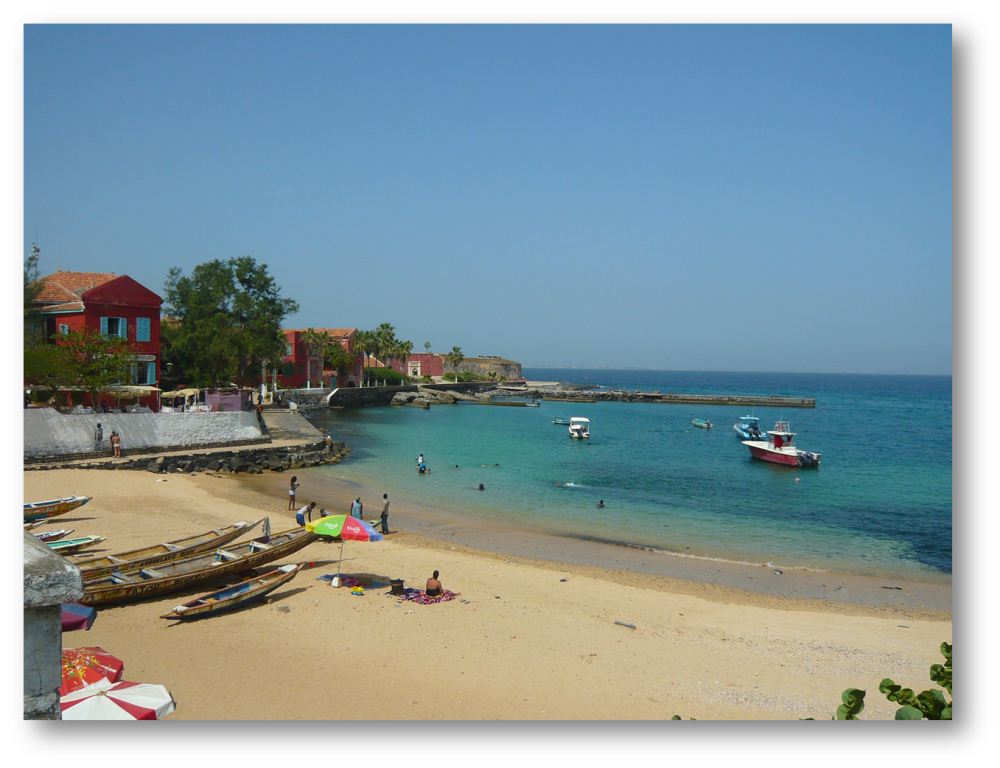
In the little harbour you can barely fit one pirogue and two beach umbrellas.
|
|
| |
| TOP
|
| |
| |
|
5th to 10th November : the Siné-Saloum (193 M)
|
|
|
Shall we go, shall we not go? After some shilly-shallying we decide for a quick trip to the Saloum river. The place is notoriously calm yet treacherous: currents up to 4 knots and sandbanks moving all the time guarantee that you run aground at least once… and to reach the river we have to sail 65 miles downwind (which means a good day against the wind to come back) and through fields of fishing pots and nets. Sounds like heaven doesn’t it?
|
|
|
The riddle reads as follows: given that the tidal currents an throw you out of the pass and that the fishing nets can be seen only in daylight, what time do we have to leave Dakar? 11pm is the answer. The trip to the Saloum is a nice downwind run, keeping off the coast as to avoid all boats and nets, with the front sail up only. The tradewind is strong and stable. Only an oil platform and some trawlers later, the sun rises, the wind veers to the west and we have to turn the engine on to help against the wind through the pass. 5 miles before the river, by 10m depth we saw lots of small flags indicating pots. No net luckily, but at places the flags are so dense that you have to keep off the whole field altogether. To the river itself the entry is “new” (a strong tide dramatically changed the sandbanks between Djifere and the island of Sangomar a couple of years ago) but perfectly marked. You have only to find the first green / red couple and follow the path. |

The new pass is well marked: two beacons, then red, green, red, green, red and a last couple – you're there !
|
|

By the river: mangrove and palm trees
|
Once inside the wind picks up from the West again and we keep on upstream slowly pushed by a feeble breeze on flat water. At neap tide we had no more than 1.3 knots current actually. The river sides are flat and low, bright green with mangrove. Here and there the silhouette of a palm tree or a baobab reminds you that you are indeed in Africa – and not back in Zeeland!
|
|
|
As the night is falling we enter in one of the side streams to the river, called “bolongs”. Another yacht is anchored here already: good news (it’s deep enough for a keel), and bad news (we are not as isolated as we wished). On the other side the village of Guirnda is getting ready for the Tabaski tomorrow (the Day of the Sheep, main holy day in the muslim religion). The air is filled with bleating. The next day at 10 am it’s going to be much quieter – poor sheep… We enjoy a good night’s sleep by the mangrove.
|
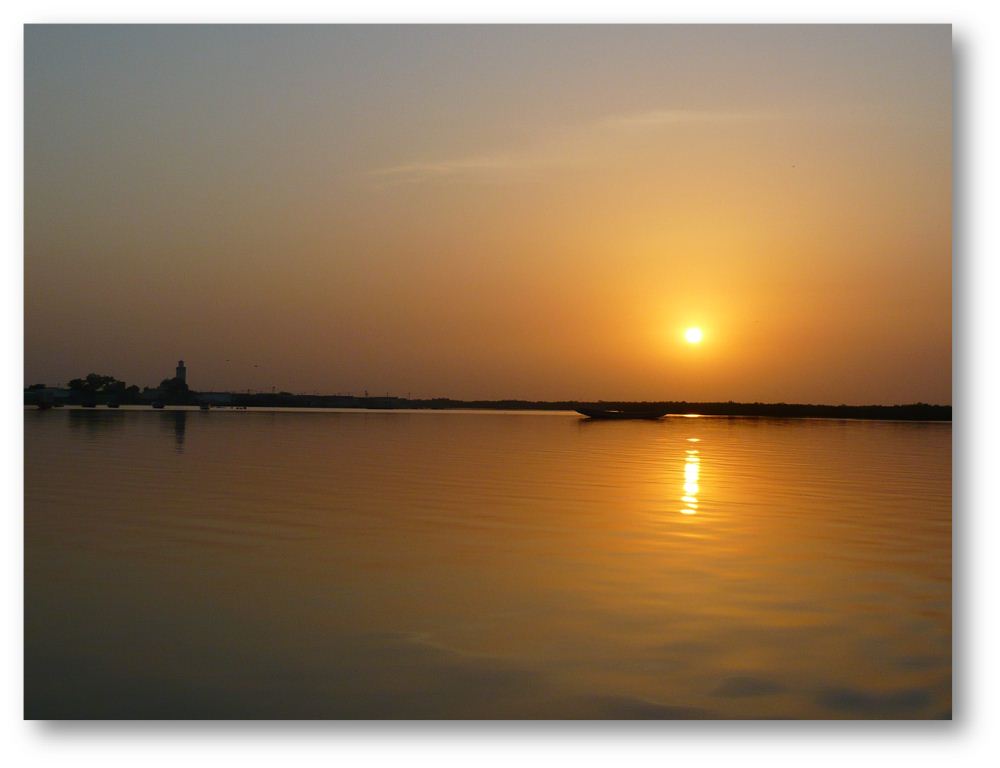
The sun rises on the village of Guirnda
|
|
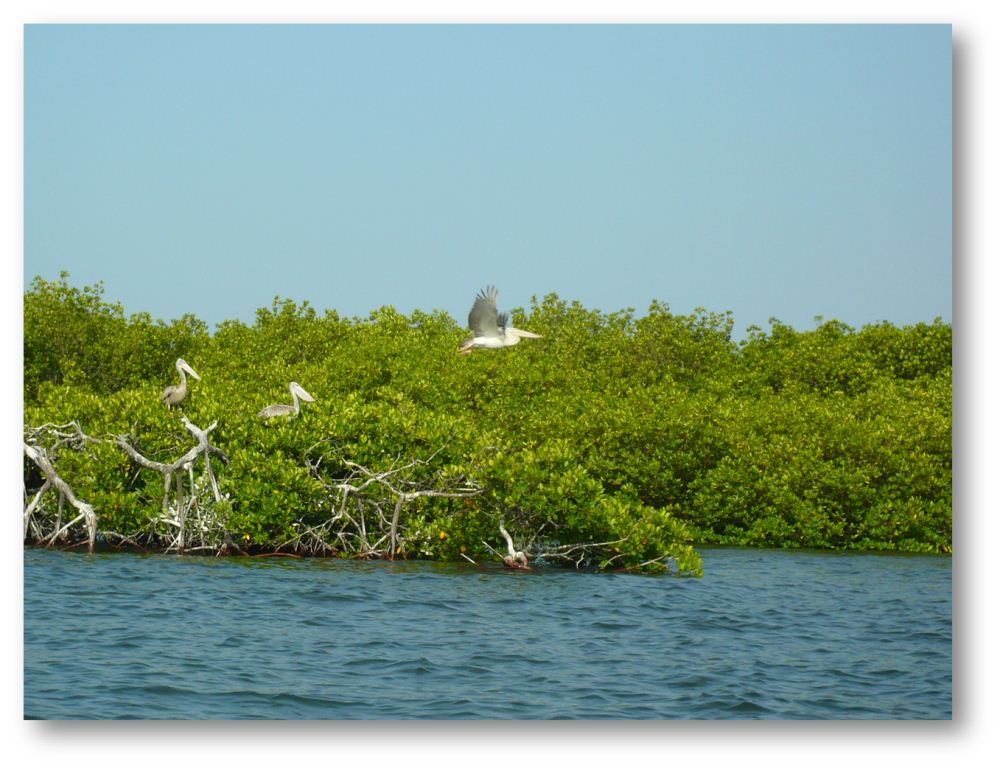
Pelicans flying away
|
On the next morning the alaram goes off at 6. We want to leave early and see the birds on the island of Ndar, 3 miles upstream. We drop the anchor on the side of the island (8m deep) and inflate the tender to get closer into the mangrove. The first birds that we see are nothing less than big grey and white pelicans, lazily flying odd as we sail past. On the Eastern side of the island, where the channel goes, it is rather dull. But on the Western side no boat can sail and it is full of life! All sorts of birds and peeping. Cranes, cormorants, white ibis-like birds and even weird flamingoes with flat beaks.
|
|
|
Engine off we paddle in silence. We get inside the mangrove. There is no soil, the dark roots of this “island” formed of trees plunge in the water directly. Full of life: crabs, crocodiles too as they say (we saw lots of the first and none of the latter). On the roots dark grey oysters grow. They are delicious!
|
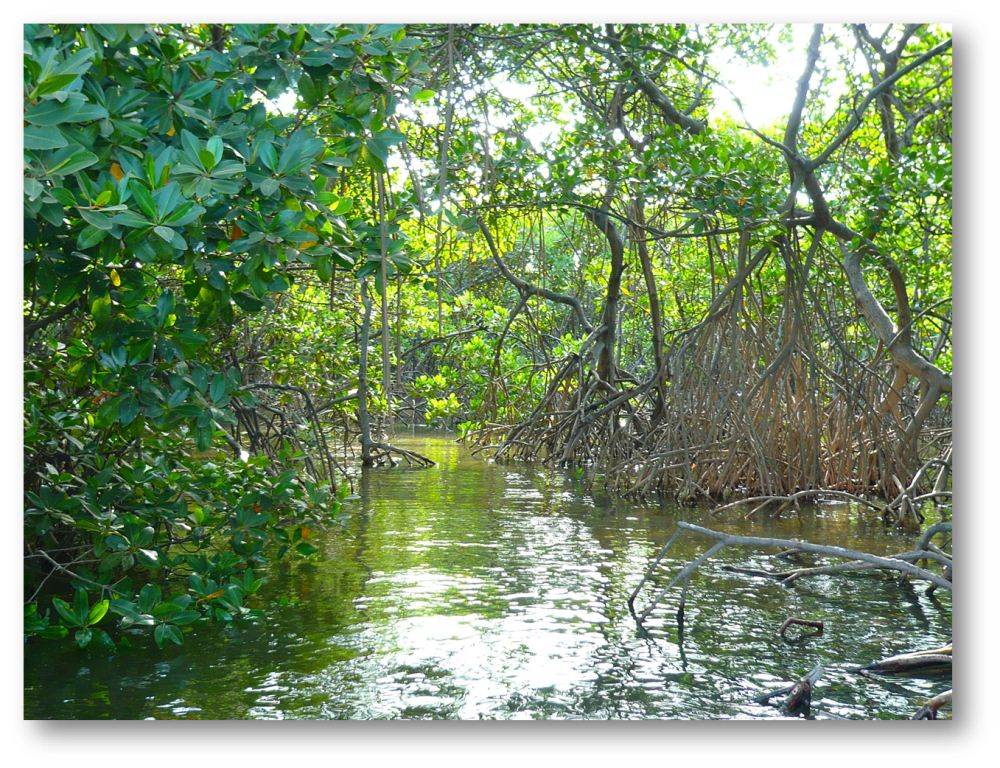
Deeper into the mangrove...
|
|
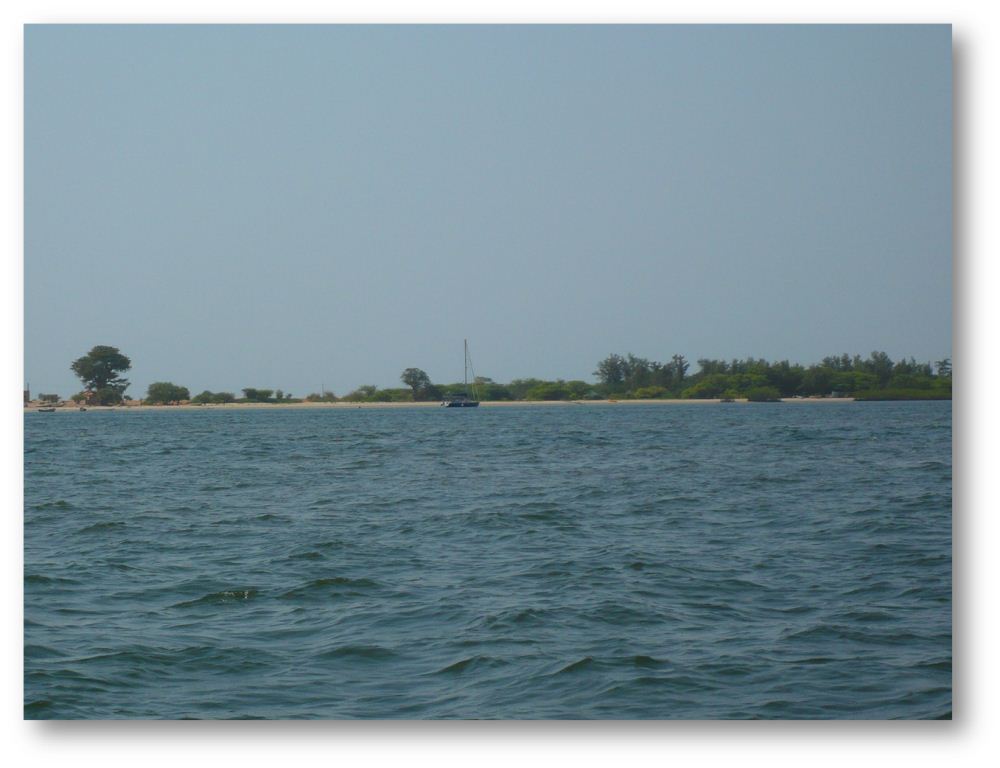
Djifere lies at the entrance of the Saloum
|
Back to the boat as the tide is changing to flow outside. Another 1.5 knots current helps us down the river to the entrance. The wind has turned East, just in our backs: life is keen to us sometimes. It’s a very hot day and we’re looking forward to some cleaner water by the mouth of the river to take a dive in. We sail past Djifere (a group of 25 boats are expected tonight – we’d rather see birds only). Just South of the entrance to the river, across from the island of Sangomar, the Marigot of Gokhor offers more tranquility near the village of Dionouar.
|
|
|
According to our « Cruising Guide for West Africa », the pass is tricky and shallow (2m only). Our paper chart dates back to 1953, imagine how many tides have remodeled the banks since then! Yet by chance we find the deepest of the channel and see never less than 4m on the echo sounder. The route is: coming from the entrance channel to the Saloum, turn South to the couple of beacons (the green buoy being red with rust, yet still conic); keep sailing South in the channel until 13°53,0 N; then turn to the entrance at 30 degrees. Bear on this route passing the beach until the sea becomes riddled in front of you and small waves let you see that it´s time to turn. Then to the right into the river, which becomes deeper (6, 7 then 8m, breathe, you’re safe again!)
|

Entrance to the marigot
|
|
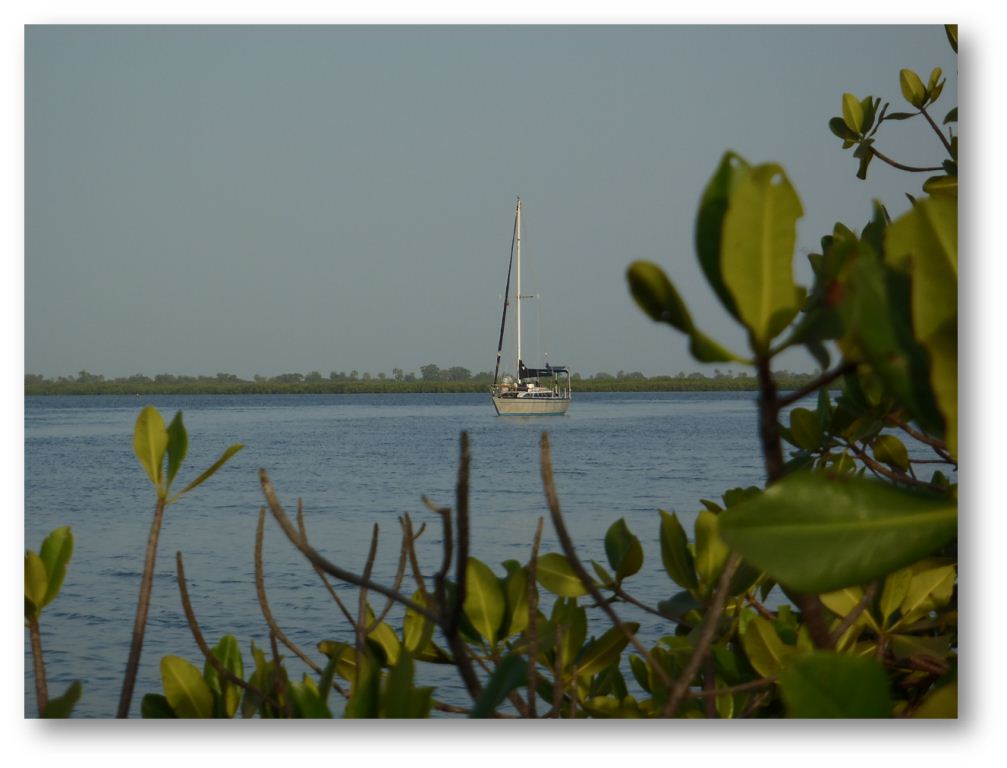
The anchorage of your dreams
|
On the Southern side: a beautiful white sand beach with mangrove and palm trees. A tourist camp stands there but is hidden by the trees already 100 meters up the river. We drop the anchor in 8m water on sand and mud. The current is rather strong, less so by the bank. There’s absolutely no one around – only nature, and us, enjoying every bit of it.
|
|
|
Going ashore swimming! The water is so hot that it barely provides a cool sensation. It feels like you’re sweeting when you swim. Then a shower on the deck and a nice beer watching the sun set amongst the palm trees… if only for those moments it was worthwhile sailing down there. At dark the mosquitoes attack and we have to duck in our closed boat protected by a couple of mosquito-nets.
|

Sunset
|
|
|
Yet the time is short and the world is wide, we are thinking about the Cape Verdes already. On the next morning we sail off and head towards the pass, full of confidence as we had no issue on the day before. For the sake of security we turn the computer on and couple it to the GPS to see our position live on the chart… Laure is piloting the boat from the screen as Camille steers: “to the right, there’s 5 to 6 m” – “no no, it’s 3…2…1.5m!!” damn, where’s the pass? Back to the good old charts and recollecting memories from the day before, we find that we were too much to the North, and that the computer charts from 2000 are not as reliable as the paper from the '50s…so much for technology, give us a good compass instead!
|
|

Not sure what it is, but it's yummy!
|
Sailing up to Dakar is a quiet ride to the wind at first, close to the wind but on a direct course in a nice 3 bft. We catch a fish unknown to us (later identified as a “caranx”): tastes like mahi-mahi, has the texture of a tuna. Good size, we’ll have two nice meals !
|
|
Night is falling and the wind picks up to 20 knots. Saltimbanque gets back into the “strong against the wind” mode he learnt in the North Sea and runs smoothly on a big swell. Some water gets in through the window joints, the sun damaged the rubbers, that’s easy to fix luckily. And getting wet is almost welcome, so hot as it is.
We reach the CVD as the sun is rising. Nestor surprised us by refusing to get on: no power in the starter! No biggie, we know the place and drop the anchor with the mainsail on (elegant maneuver!). After drying in the sun, he starts again like nothing ever happened. Well, well, one has his mood swings…
Back to Dakar now. Taking water, fuel and food and getting our passports stamped out. We are leaving one continent, the next is 2200 miles to the West – and on our way, the Cape Verdes…
|
|
| |
| TOP
|
| |
| |
|
|
|
|
|
